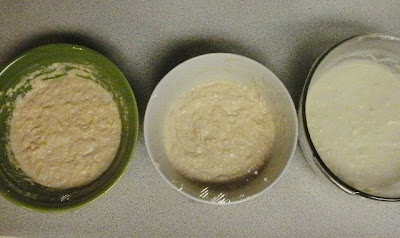Last week I followed along with Mamal Diane in making some sourdough starters by catching wild yeast, and then baking with the starter.
This was an experiment of sorts, as we each made three starters: one with whole wheat flour, one with white flour, and one with a 50/50 mix of whole wheat and white flours.
Here is how the starters looked on the first day:
They are each just a mixture of 1/4 cup filtered water and 1/4 cup flour. Each day, I added 1/4 cup filtered water and 1/4 cup flour to each jar, and set them up on a shelf in our living room. Why the living room? Because I have both kombucha and water kefir culturing in the kitchen already. Wild yeasts can cross-culture, and with two already in the kitchen, I didn't want to add another. I could have cultured the sourdough outside, but we had a lot of rain when I first started them, so I didn't want to do that, either.
I also read that it only takes 24-48 hours to catch the yeast for the starter, but I was following Diane's lead. I wanted to do it the way she did, so we could compare notes fairly.
After the first day, they didn't really have much of an odor, but by the second day, they were starting to smell sour. As the week progressed, they got downright stinky. The second day also seemed to be the day they were most bubbly, and when that dissipated, I wondered what kind of results I'd get. I've read that my part of the country (western Missouri) isn't known for strong wild yeast. Not one to let a little technicality like that stop me, I pressed on.
By the 4th or 5th days, the whole wheat and mixed starters were smelling almost fruity, kind of like apple cider. The white flour starter was still stinky. But all were nice and bubbly again.
It wasn't until the 8th day that I mixed up the "sponges", per this recipe that Mamal Diane had linked. I decided for my first round of baking I would use the white flour starter to make three batches - one with white flour, one with a mix of white and wheat flours, and one with whole wheat flour. That way I thought I'd be able to tell how the starter developed each of the types of flour.
Here are the freshly mixed sponges, with whole wheat on the left, white on the right, mixed in the middle.
The sponge needed to sit overnight, so I was able to bake yesterday. Here is what the whole wheat sponge looked like after about 15 hours at room temp.
This is the whole wheat sponge poured out onto the floured counter top. It's also where I became confused by the recipe. It said to work the flour in, but it didn't say how much. So I guessed, based on my previous bread-baking experience. I didn't measure, I just worked in the flour until the dough felt right to me.
Here are the loaves after baking. Again, whole wheat is on the left, white is on the right, mixed is in the middle.
And here they are after cutting. Same order.
Upon tasting, they are all fairly sour. The texture was dense. I'd hoped for a more porous texture, so maybe next time I'll work in a little less flour. The white loaf just tastes sour, while the wheat loaf tasted like sourdough and raisin bran cereal. The mixed loaf had a nicer flavor, but I thought the crust was too thick on all of them. Overall, this isn't quite what I'm looking for.
But, surprise! Kat loves it! We used the bread for pulled pork BBQ sandwiches last night, and then after supper, she asked for more bread. And I heard no complaints from Shane, either, and he is not someone I'd consider a sourdough fan.
I have lots of starter left, so I'll be trying more sourdough recipes for bread, waffles and other baked goods, comparing all three kinds of flour when I do. However, unless I stumble upon a recipe we all love, I'm not going to feed these starters to keep them going. I think I'll try a 48-hour starter to see if that's something I like better.
Stay tuned. I'll be making science in the kitchen again soon!






